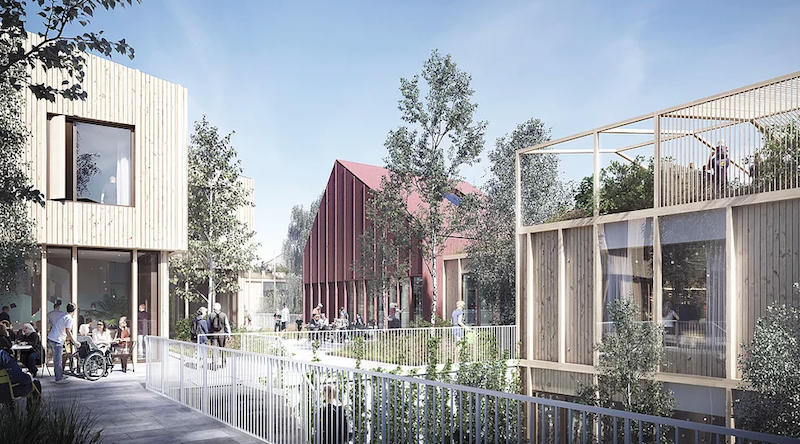A purpose-built “Alzheimer’s Village” in the French commune of Dax will give residents the ability to roam free and go about their daily lives in a new approach to treating the disease. According to The Telegraph, residents will live in shared houses in four districts reminiscent of the southwestern French region.
The village is designed to look like a medieval-style bastide, which is common to the area and will help prevent patients from becoming disoriented. Designed by NORD Architects, the village will have a local shop, a hairdresser, restaurants, a cultural center, and a healthcare center. Additionally, volunteers will help to stage activities for the residents.
The idea behind the new design approach is that the freedom the design provides will allow patients to lead an almost normal village life and maintain their participation in a social life (which recent research has shown to be a strong factor in living longer, healthier lives).
 Oslo Alzheimer's Village with CLT construction. Courtesy NORD Architects.
Oslo Alzheimer's Village with CLT construction. Courtesy NORD Architects.
Plain-clothes medical staff will watch over the residents, who are confined to the village for their own safety, and researchers will conduct a study to see if this new style of care helps patients remain more active, require less medication, and live happier lives. In total, the village will support 120 Alzheimer’s residents, 100 live-in caregivers, and 120 volunteers.
NORD Architects is also working on an Alzheimer Village in Oslo, Norway and will use CLT to construct the project’s various buildings.
Related Stories
| Oct 30, 2014
CannonDesign releases guide for specifying flooring in healthcare settings
The new report, "Flooring Applications in Healthcare Settings," compares and contrasts different flooring types in the context of parameters such as health and safety impact, design and operational issues, environmental considerations, economics, and product options.
| Oct 30, 2014
Perkins Eastman and Lee, Burkhart, Liu to merge practices
The merger will significantly build upon the established practices—particularly healthcare—of both firms and diversify their combined expertise, particularly on the West Coast.
| Oct 21, 2014
Passive House concept gains momentum in apartment design
Passive House, an ultra-efficient building standard that originated in Germany, has been used for single-family homes since its inception in 1990. Only recently has the concept made its way into the U.S. commercial buildings market.
| Oct 21, 2014
Hartford Hospital plans $150 million expansion for Bone and Joint Institute
The bright-white structures will feature a curvilinear form, mimicking bones and ligament.
| Oct 16, 2014
Perkins+Will white paper examines alternatives to flame retardant building materials
The white paper includes a list of 193 flame retardants, including 29 discovered in building and household products, 50 found in the indoor environment, and 33 in human blood, milk, and tissues.
| Oct 15, 2014
Harvard launches ‘design-centric’ center for green buildings and cities
The impetus behind Harvard's Center for Green Buildings and Cities is what the design school’s dean, Mohsen Mostafavi, describes as a “rapidly urbanizing global economy,” in which cities are building new structures “on a massive scale.”
| Oct 13, 2014
Debunking the 5 myths of health data and sustainable design
The path to more extensive use of health data in green building is blocked by certain myths that have to be debunked before such data can be successfully incorporated into the project delivery process.
| Oct 12, 2014
AIA 2030 commitment: Five years on, are we any closer to net-zero?
This year marks the fifth anniversary of the American Institute of Architects’ effort to have architecture firms voluntarily pledge net-zero energy design for all their buildings by 2030.
| Oct 8, 2014
Massive ‘healthcare village’ in Nevada touted as world’s largest healthcare project
The $1.2 billion Union Village project is expected to create 12,000 permanent jobs when completed by 2024.
| Oct 3, 2014
Designing for women's health: Helping patients survive and thrive
In their quest for total wellness, women today are more savvy healthcare consumers than ever before. They expect personalized, top-notch clinical care with seamless coordination at a reasonable cost, and in a convenient location. Is that too much to ask?

















